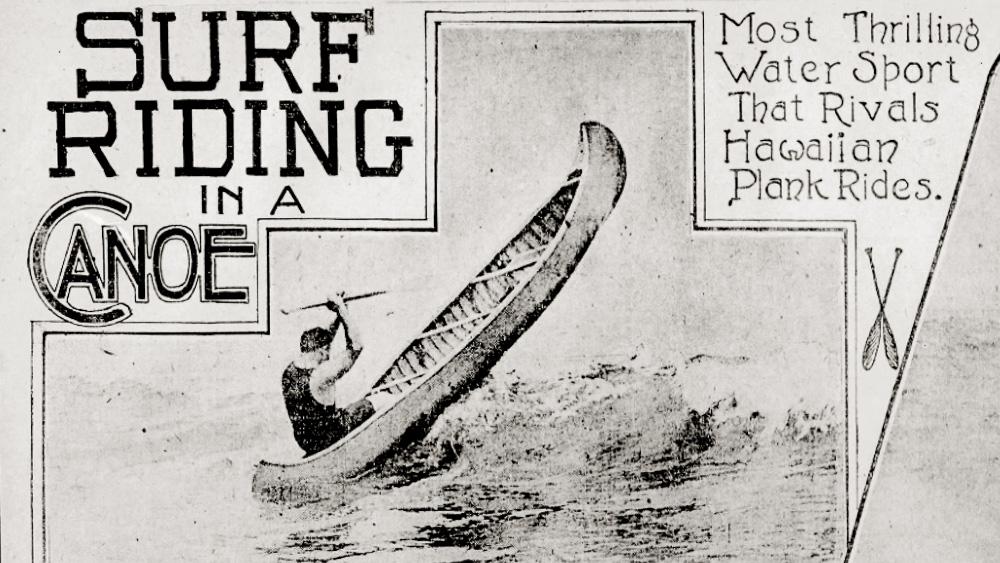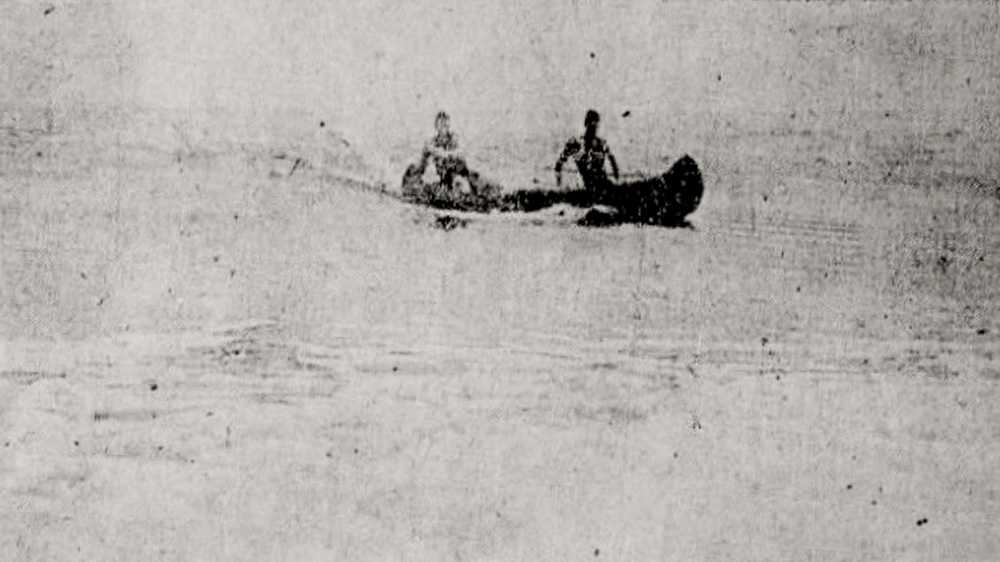"SURF RIDING IN A CANOE: MOST THRILLING WATER SPORT THAT RIVALS HAWAIIAN PLANK RIDES" (1913)

"Surf Riding in a Canoe" was the top story on the Special Features section of the August 10, 1913, edition of the Virginian-Pilot. This version has been slightly edtied
* * *
The sport of surf riding on a plank has for many years been one of the chief attractions to visitors in Honolulu. The natives enjoyed the pastime for years before Uncle Sam threw his protecting arm over the island and benevolently assimilated it. Then came an influx of white people, who took up the care-free manner of living the natives were accustomed to and also adopted their sports, including the plank-riding [surfing].
So adept became the Americans at this sport that they now have the champion.
It Is nothing unusual to shoot along before a wave for a full mile on one of these planks and some of the cracks can come in standing erect or standing on their heads, balancing with their hands on the sides of the plank.
The peculiar formation of the Hawaiian coast develops a wave that makes-up a mile or more offshore and comes as a steep swell, rolling in until it breaks on the beach. The plank riders swim out with their planks to where these swells make up and, when a big one comes, they give a strong push toward shore in front of the wave, which picks them up and sweeps them along with it, their plank serving as a float and boat.
There is no place on the Atlantic coast which can boast the long waves that makes plank riding a possibility in Honolulu, for the waves, as a rule, never make up further offshore than three or four hundred yards, rarely more than two hundred yards. And they do not come steep enough to pick up a slowly moving plank and carry it along. They lift it, slide under it, and are gone, leaving the plank bobbing In their wake.
For this reason there cannot be any plank riding in this part of the country. A plank has been brought from Honolulu and tried out at Virginia Beach under almost every condition, but It was a failure.
There is a sport enjoyed at the Beach, however, that is every bit as thrilling and exciting as the Honolulu pastime from which It was copied.
It Is riding the waves in a canoe.
When it was found impossible to use a plank because of the inability to get sufficient momentum before the wave struck it, the canoe was tried out and proved to be an overwhelming success.
Any afternoon at the Beach during the summer season will find a dozen or more canoes, manned by from two to three young men, occasionally by one man, or a man and a girl, whizzing down the steep side of a wave, half-buried in foam and spray and landing head-on to the beach.
It Is the most exciting water sport known, for the canoe is at best an unstable craft and skill is required to keep it from capsizing, even in still water. So one can readily imagine the necessity of a “knack” to successfully steer and balance one of them over the curve of a breaker, sometimes dropping six feet and then, with the wave roaring and tumbling behind, to come safely and straight to the shore.

In surf riding in a canoe the crew, to be expert, must be "one with the boat,” on the same principle that a good horseman must be a part of the horse. The canoe riders must know their craft, know it well enough to feel its every motion, to even know what it is going to do beforehand and be able to shift their weight to meet the change. Otherwise, there is a spill as sure as the sun rises In the morning.
This acquired, there is nothing difficult in learning to shoot the waves, except the knowledge of judging waves, where they will break and the proper amount of momentum needed to force them to carry the canoe along.
For those who have never seen surf riding in canoes, this brief description of the sport will serve to convey an idea of It, though no words can afford one the sense of thrill and exhilaration that comes with the sport itself.
The canoe crew who are going to shoot launch their craft through the surf, carefully waiting until there are no large waves ahead of them, for a canoe is like a bucking bronco when it meets an oncoming swell, as one of the pictures on this page will show.
Safely beyond the breakers, the steersman, who sits in the stern seat, heads to sea until he has reached a point where he judges, from watching the formation of the waves, that the swell will be steep enough and far enough out from the breaking point, to carry the canoe in. Then he turns the craft until its bow points to the beach and, looking seaward, watches for the coming of the wave he wants.
A half dozen lesser swells will come and then he sees the big one making up. When it is about fifty yards from him, he gives the word to paddle and both he and the bow man put all their strength behind their paddles to gain the needed momentum. The wave is steadily rolling up behind them and finally it reaches them. It picks up the stern of the canoe, pointing the bow down and the little craft shoots shoreward, steadily gaining speed as the wave grows steeper.
By this time the bow man has stopped paddling and has slid back out of his seat and is sitting in the bottom of the canoe abaft of midship. This is done to keep the bow from going down too much and swamping the craft.
The steersman, holding his paddle close to the side of the boat with one hand, works it right and left with the other, to keep the course true to the beach, for once it swerves the odds are ten to one against straightening out again, and the onrushing wave will surely whirl the boat over and bury it as it breaks.
But if the steersman holds a true course the wave will come along behind, pushing all the time, and at last, as it nears shore, curve and break. This crash of tumbling water behind sends the canoe whizzing forward, with the stern seemingly entirely beneath a flood of foam. But somehow the boat is always just a few Inches in front, and it goes steadily on until the sand stops it at high water mark.
Last Sunday the surf was exceptionally good for riding and some of the canoes scored distances of over three hundred yards, one coming in from the end of the fishnet stakes in front of the Waverly Cottage. This ride was made by Joshua Garrison and Vivian Hodgson and is said, by those who saw it, to have been the longest ever made at the Beach.
The canoes, if properly handled, can meet the biggest waves and master them, if the sea is not too choppy. When the water is rough, with a high surf running, the 18-foot dories are launched and the surf riding in them is just as thrilling as in the smaller craft, with more danger, for an overturned dory is a bad thing to be struck by, and they frequently overturn. The dories are manned by two oarsmen and a steersman, the former pulling 14-foot oars and the latter using one four-feet longer to steer with. A passenger is carred who stands opposte the steersman to help balance the boat and when the dory shoots down the crest of the wave the oarsmen put up their oars, making a very pretty picture as the boat comes sweeping in through the foam.
Surf riding is becoming more popular at Virginia Beach every year and is indulged in at that resort more generally than at any other on the coast.